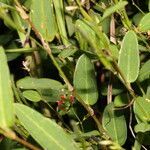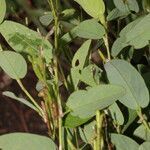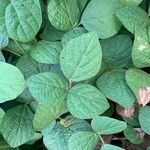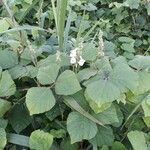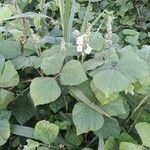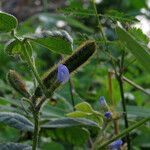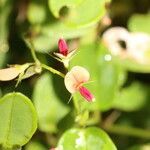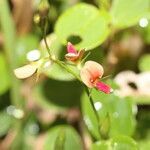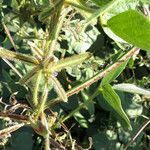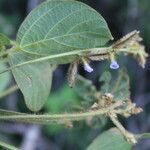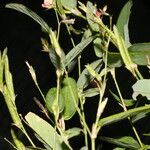Trailing or twining herb 1-several m. long, densely pilose with long spreading ferruginous hairs.. Leaflets elliptic, ovate or rhomboid-ovate, (1·5–)4–10(–15) cm. long, (1·3–)2–5(–9·3) cm. wide, obtuse or subacute and apiculate at the apex, rounded at the base, the laterals oblique, adpressed pilose or pubescent on both surfaces; petiole 2–16 cm. long, pilose; rhachis 0·5–2·2 cm. long; stipules ovate-lanceolate, 4 mm. long.. Inflorescences 1–10 cm. long above a peduncle 0–17 cm. long, ferruginous pilose; fascicles ± 6-flowered, often well-separated or sometimes single and subsessile; pedicels very short; bracts and bracteoles lanceolate, 4 mm. long.. Calyx campanulate, 6–8 mm. long, pilose; teeth subulate, the upper 2 about as long as the tube, the lower 3 longer.. Standard blue, 0·7–1 cm. long, 5–6 mm. wide, emarginate.. Ovary hairy; style glabrous, about as long as the ovary.. Pods linear-oblong, 2–4 cm. long, 3·5–5 mm. wide, straight or curved, densely bristly ferruginous hairy, 5–8-seeded, transversely impressed between the seeds; fruiting pedicels 2–3 mm. long.. Seeds dark brown or yellow-brown, squarish or oblong, longest dimension 2·5–3·7 mm., shorter dimension 2·5–3 mm., 1·5–2 mm. thick; hilum small, round, central, with a short impressed groove at one end.
A trailing or twining herb. It grows to several metres long. The stems are covered with long spreading rusty hairs. The leaflets are oval and 1.5-16 cm long by 1.3-11.5 cm wide. They are rounded at the base and ending abruptly in a small tip at the top. The side leaflets are slanting at an angle, and hairy on both sides. The leaf stalk is 2-16 cm long. The flower arrangements are 1-10 cm long, on stalks 0-17 cm long. These stalks have rusty hairs. There are 6 flowers in a cluster but these are well separated. The largest petal is violet or blue. The fruit are long and narrow and 2-4.5 cm long by 3.5-5 mm wide. These pods can be straight or curved. They have rusty hairs and 5-8 seeds. The seeds are dark brown and almost square. They are 2.5-3.7 cm long by 2.5-3 mm wide. The seed scar is round, and in the centre.
Herbs, twining or procumbent, densely hirsute with spreading fulvous hairs. Stipules triangular-lanceolate, 4-5 mm; petiole 4-12 cm; stipels subulate; terminal leaflet ovate-rhombic, lateral ones obliquely ovate, 4-10 × 2-5 cm, broadly cuneate to rounded at base, acute or blunt at apex. Inflorescences 1-10 cm; flowers 5 or 6, clustered at nodes of rachis; bracts and bracteoles linear-lanceolate, ca. 5 mm. Calyx tube glabrescent; lobes longer than tube, linear-lanceolate, densely appressed hirsute, long acuminate at apex. Corolla purplish; wings obovate-oblong; keel straight, with short auricles. Ovary densely hirsute. Legumes linear-oblong, 2-4 cm × ca. 4 mm, straight or slightly curved, with appressed long brown bristles, 5-or 6-seeded. Seeds ca. 2.5 × 2 mm. Fl. Oct.
Leaflets (1.5)4–10(15) × (1.3)2–5(9.3) cm, elliptic, ovate or rhombic-ovate, obtuse or subacute and apiculate at the apex, rounded at the base, the lateral leaflets oblique, appressed pilose or pubescent on both surfaces; petiole 2–16 cm long, pilose; rhachis 0.5–2.2 cm long; stipules 4 mm long, ovate-lanceolate.
Inflorescences 1–10 cm long above a peduncle 0–17 cm long, ferruginous pilose; fascicles c. 6-flowered, often well separated or sometimes single and subsessile; pedicels very short; bracts and bracteoles 4 mm long, lanceolate.
Pods 2–4 cm × 3.5–5 mm, linear-oblong, straight or curved, densely bristly ferruginous hairy, 5–8-seeded, transversely impressed between the seeds; fruiting pedicels 2–3 mm long.
Seeds dark brown or yellow-brown, 2.5–3.7 × 2.5–3 × 1.5–2 mm, squarish or oblong; hilum small, round, central, with a short impressed groove at one end.
Calyx campanulate, 6–8 mm long, pilose; teeth subulate, the upper 2 more or less equalling the tube in length, the lower 3 longer.
Trailing or twining herb 1–several m long, densely pilose with long spreading ferruginous hairs.
Ovary hairy; style glabrous, more or less equalling the ovary in length.
Standard blue, 7–10 × 5–6 mm, emarginate.
Deep blue flowers
A hairy climber
